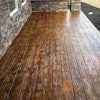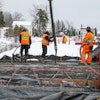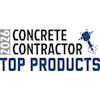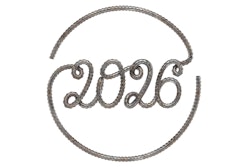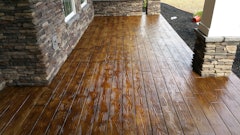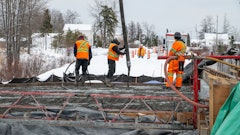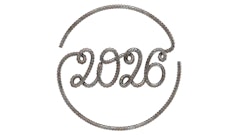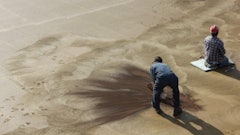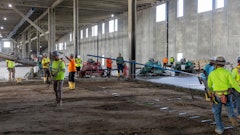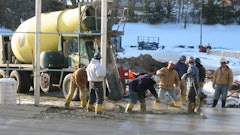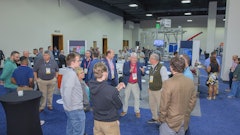
Let’s be honest, concrete isn’t going to be the number one response in a short list of decorative building material options for luxury construction projects. But, if you think about it, that mentality has been slowly changing.
The context of luxury construction changes, reflecting the culture and time of the moment. For instance, in the 1980’s and 90’s, concrete design purposes were mostly what you see in urban lofts such as a concrete floor, a brick wall, some columns, etc. Those choices can be seen elsewhere as well, such as oceanfront property, atop of a ski resort, a Montana ranch — even Tony Stark’s mansion in Marvel’s Iron Man 3 featured cantilevered concrete overlooking a cliffside.
For one example set in reality, we go to Paris. The premium decorative concrete contractor, Design & Beton, was hired for the flagship boutique for Marc-Antoine Barrois. The interior’s luxurious, polished look is achieved through a custom blend of Australe Concrete’s micro‑cement, incorporating a carbon-stored concrete material from construction material producer Paebbl. Decorative concrete contractor and producer reviewed numerous alternative systems, ranging from traditional resin terrazzo to lime‑based composites, before fine‑tuning the color, grain size, and sheen to meet the exacting standards of the boutique, ensuring every step in‑store carries both beauty and a net‑negative carbon footprint.
Located at 14 rue du Faubourg Saint‑Honoré, one of the city’s most prestigious addresses, the 30 m² micro‑cement application not only elevated the store’s aesthetic but also demonstrated how sustainability and high‑end retail design can go hand in hand.
“From the very first samples, we knew Paebbl could give us a seamless surface that behaves like classic polished concrete yet stores carbon for good,” says architect Antoine Bouillot. The design concept, as Bouillot calls it, was a “symphony” featuring a combination of rare woods, sculpted metals, and cement. The Paebbl solution is a mineralization process that permanently locks away captured CO₂. By partially substituting conventional cement with Paebbl’s material, contractors can directly embed carbon into the structure.
For Bouillot, “[it proved] that refined luxury can and must adopt a virtuous materials palette.”
Barrois adds, “Our house has always celebrated craft and rarity. Partnering with Paebbl allows us to extend that philosophy into the floor beneath our clients’ feet, marrying French savoir‑faire with the most advanced climate technology available.”
“This flagship is the perfect stage to demonstrate how design and sustainability can converge,” notes Frédéric Ljung, Senior Advisor at Paebbl, also co-founder of Australe Concrete. “We’ve always believed that carbon-storing materials should not be confined to industrial-scale projects but become an everyday choice for architects, contractors, and brand owners who appreciate both style and substance,” adds Ana Luisa Vaz, VP of Product at Paebbl.
In the cast-in-place industry, the design is only limited by what the contractor can do with their formwork system. For example, Richard Cofoid, senior product and marketing manager at Euclid Chemical, was invited to check out a $25 million (range) home in Miami. The contractor had some finishing questions. The three-story home featured three stories of concrete walls poured over several lifts with rounded corners, a large cantilever deck with an open atrium.
Another example was a residential construction being placed on the Big Island of Hawaii. The design incorporated the volcanic pumice stone into the design, shaping and coloring the concrete to resemble the natural materials in an outdoor pool area. Then, the owner wanted that natural stone design to continue in the interior of the home. Custom form liners were made so contractors can integrally color the concrete to match the surrounding rocks.
Examples aside, even if the building owner wants a particular texture, the idea here is that a concrete surface is the finished product. There’s even been advancement in reducing and minimizing the chances of cracks, not to mention being more environmentally friendly through materials as well as thermal mass.
 The Euclid Chemical Company
The Euclid Chemical Company
Other ways concrete makes a good option for high-end projects:
- Advanced chemical technologies/admixtures such as super plasticizers to increase the flow and pumpability — helping to place concrete in those 3 to 4 story mega mansions
- Air entrainment in concrete to better withstand free thaw
- Self-consolidating concrete to aid in getting a smooth, perfect surface
- Water reducers to increase the concrete’s strength
- Fiber reinforcement and higher mix designs allow architects more design capabilities, like cantilever decking, post-tensioned slabs, curves, columns, and more
- Precast glass-fiber reinforced concrete panels can be produced in a controlled factory setting to allow unique, intricate designs
For contractors, the flip side of this is that it “ups the game” a bit. “[The contractor] doesn’t have to be engineers, but they need to be partners in the project from the get-go,” says Cofoid.
He suggests it should be more of a collaborative process — a partnership between the contractor, the architect, the engineer, the general contractor, and even the ready-mix supplier, so everyone involved has an understanding of the goal(s) at hand. Why does the designer want a particular admixture in the mix? Why a specific aggregate vs something else? Details matter. Decisions matter. No matter the scope of the job, every detail can affect the result.
Elsewhere
The question now is how to apply the mentality of placing concrete for a high-end job to everything else. It’s that attention to detail, even something negligible, that will keep that quality up.
“You don’t have to be an artist, but you have to have some attention to detail,” notes Cofoid.
That, combined with keeping good communication, might just take the finish to the next level. Maybe instead of just a broom finish, suggest a checkerboard pattern or an option to frame the job with edging. If stamping the entire driveway isn’t, perhaps suggest the beginning pad by the door or just the border with an integrated color on the inside.
These conversations can apply what was done on the mega expensive places to the standard driveway, giving customers something to be proud of with a bit more curb appeal. Afterward, some contractors bring photos to their next jobs and market their talents. This has been taught on the decorative concrete side for years.
As far as adding to your services as a contractor, Cofoid suggests education and build experience by starting small. “Get together or be known with some of the architects and designers putting these homes together,” he adds. “They’re not out after the lowest bid. They want a fair bid with a company they know that can do the work because they have proven themselves before.”
Not many start with the 8,000 sq. ft. home with cantilever decking — so start small. Another idea from Cofoid is to look into the local parade of homes to discover the custom home builders and offer your services.
“Breaking into the really high-end of the business is pretty difficult,” he says. “I think you need to do that from the ground up and have that relationship already so you’re the go-to that people already see as an expert.”
Editors Note: The Euclid Chemical Company was not associated with the Marc-Antoine Barrois boutique or Paebbl.

